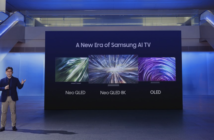Whilst Samsung might have diverted the crowd’s attention to their latest smartphone and wearable technology, they also showcased some of the other mobile technology they were working on at their LSI booth; they were showcasing their new Exynos processors, CMOS Image Sensors, NFC IC and a Wi-Fi chipset.
Smartphones are becoming powerful more than ever and with advanced technology such as LTE for faster data transfer, applications are becoming more than just apps for fun, display sizes are becoming bigger and users are now consuming more content on the go however with those growth comes other compromises by manufacturers as those improvements takes its toll on battery life, efficiency and a device that runs smoothly without lag and other problems.
Samsung are now working on ways to improve user experience with better chips and the way they communicate, interact and integrate with smartphones and other use cases too. Rather than just bumping up the battery power in a smartphone, there are other areas that also require improvements in conjunction with what how powerful the battery is; the processor needs to be efficient.
New Processor Architectures
Samsung’s new Exynos 5422, is aimed for maximum efficiency with the support for high-resolution displays; Samsung’s new processor is equipped with eight cores which comprises of —four big ARM Cortex- A15 cores clocked up to 2.1 GHz to handle heavy loads and four small ARM Cortex- A7 cores clocked up to 1.5 GHz for lighter jobs.
Samsung claims that it delivers up to 34 percent higher performance than in previous Exynos Octa models. Due to Samsung’s further optimized big.LITTLE HMP (Heterogeneous Multi Processing) technology, any combination of up to eight cores is engineered to provide optimum performance for any given task.
To further put it into simple terms, the processor architecture means that the processor power is distributed to handle the required application or process as per when need, for example, rather than using bigger processor resources for little tasks there by causing redundancies, bigger processor will handle bigger tasks. This type of architecture also means less strain on the smaller cores because rather than trying to chew more than they can swallow and causing extra battery consumption, they will only be deployed to handle small tasks or even in situations where the bigger cores are dealing with big tasks, the smaller ones can still handle the small tasks at the same time.
Samsung also introduced the Exynos 5260, which is designed to bring optimal performance and power efficiency required in the increasing mid- to high-end mobile market. The new Exynos 5 Hexa processor is powered by six CPU cores; two 1.7GHz ARM Cortex-A15 cores and four 1.3GHz ARM Cortex-A7 cores and just like the Exynos 5 Octa products, it adopts big.LITTLE HMP to provide the right mixture of cores for various tasks, which Samsung said would result in up to 42 percent improved performance when compared with the previous Exynos 5 Dual products.
New ISOCELL CMOS Image Sensors
Samsung also showed off their new CMOS image sensor technology, ISOCELL which substantially increases light sensitivity amongst other things, but the importance of the new imaging technology is to allow users to have better viewing experience especially in low light; the 16MP ISOCELL imager provides a wider, clearer viewing experience to mobile device users by implementing a 16:9 aspect ratio, allowing for full-size, high-resolution images and video to be displayed on screen without field-of-view (FOV) loss. This high-speed sensor captures full FOV 16:9 full HD (1080p) video at 60fps, and for the first time in the industry, enables continuous shooting of all 16MP at 30fps. Samples of the 16MP ISOCELL CIS are available now and scheduled for mass production in the first quarter of 2014.
Samsung’s new 13MP ISOCELL CIS features Smart Wide Dynamic Range (WDR) technology, which allows users to capture images at 30fps. With a mosaic pattern of multiple exposures, images are then processed with an advanced algorithm for wider dynamic range. This enables users to capture details clearly in both bright and dark areas even in high contrast lighting conditions. This Smart WDR feature is based on Samsung’s advanced 65nm stacked process, where the pixel array is attached right on top of the logic circuit. Samsung’s 13MP product is sampling now and is scheduled for mass production in the second quarter of 2014.
3rd Generation NFC Chip
Samsung’s 3rd generation (NFC) chip solution is the industry’s first NFC IC using 45nm embedded flash process, which enables easy and secure firmware updates as well as low power consumption.
This new NFC solution offers handset designers more flexibility by adopting the industry’s smallest antenna with enhanced radio frequency performance. This was made possible by Samsung’s proprietary Smart Antenna technology, which optimizes impedances of both receiving and emitting parts respectively to improve sensitivity and power efficiency. The NFC chip solution is currently being sampled to customers and is scheduled for mass production in the second quarter of 2014.
Wi-Fi Solution
Samsung offers its first wireless connectivity solution, S5N2120, for the growing Internet of Things (IoT) market. This solution supports IEEE 802.11 b/g/n Wi-Fi 2.4 GHz, and has an extremely small footprint, which is essential for a wide array of applications.

This solution features an integrated micro control unit (MCU) with a power amplifier, power management, audio codec and direct microphone functions. With this MCU, OEM customers can easily reconfigure their existing designs to add Wi-Fi connectivity functions. This allows for a shorter development lead-time and less engineering resources are required.
This flexibility along with excellent performance and a small footprint is optimal for battery-constrained applications such as Wi-Fi speakers, headsets, remote controls, digital & sports cameras, smart heating/cooling meters, sensors and other types of IoT or M2M applications. Samsung’s new Wi-Fi connectivity solution, S5N2120, is currently sampling and scheduled for mass production in the second quarter of 2014.







